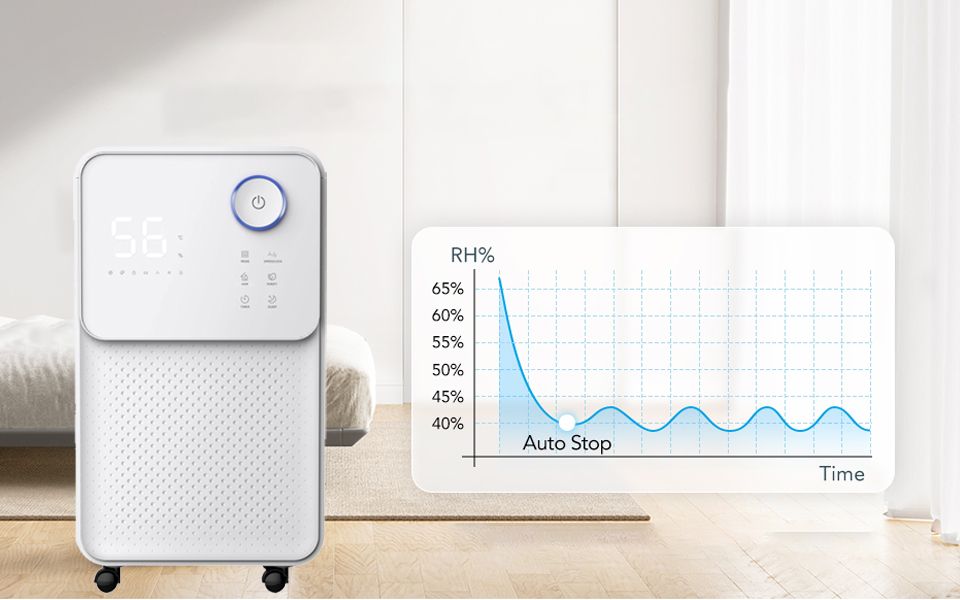
Get A Quote
How Dehumidifiers Work?-Let’s Find Out!
Whether you reside near the equator or along the coast, the term "humidity" is likely a frequent mention in your local weather forecasts. Regardless of your location, you've probably encountered that muggy, oppressive feeling that accompanies rainy, foggy, or hot weather. This discomfort not only affects your hair but can also impact your overall mood. Dehumidifers can help you ,let me show you how dehumidifiers work and why you need a dehumidifiers.
Why You Need a Dehumidifiers ?
When people grumble about humidity, they are usually referring to relative humidity, which is the ratio of actual vapor in the air to the maximum amount it can hold at a specific temperature. This level of humidity can make your home feel stuffy, musty, and, beyond superficial discomfort, pose serious disadvantages. Excessive humidity can compromise a home's structural integrity, attract pests, and even lead to health issues.
Ideally, the relative humidity in an average home at 68 degrees Fahrenheit should range between 30 and 50 percent. If you struggle to maintain this range, a dehumidifier becomes a valuable tool. Dehumidifiers play a crucial role in removing excess moisture from the air, enhancing the comfort and health of your living space.
How Dehumidifiers Work?
Imagine enjoying a cold drink on a warm day, and you notice moisture forming on the outside of the can. This happens because as air cools, it loses its capacity to hold moisture, resulting in condensation. Dehumidifiers essentially mimic this process. Key components of most dehumidifiers include:
1. Fan: Collects air and pulls it into the dehumidifier.
2. Compressor: Compresses and expands a refrigerant gas to cool the coils.
3. Reheater: Captures and collects heat generated during the cooling process.
4. Reservoir: Collects the condensed moisture.
The dehumidifier reheats the air and exhausts it back into the room. Most dehumidifiers feature a removable plastic bucket for the reservoir, and many have a hose for direct drainage or a condensate pump to prevent overflow. Some models also include a humidistat to set the desired humidity level.
Types of Dehumidifiers
1. Refrigerative Dehumidifiers: Most common, use a compressor to cool coils.
2. Desiccant Dehumidifiers: Use a desiccant material like silica gel, ideal for sub-zero conditions.
3. Portable Dehumidifiers: Lightweight, designed for smaller spaces.
4. Restoration Dehumidifiers: Heavy-duty machines for severe water damage.
5. Whole-House Dehumidifiers: Integrated with HVAC systems, require professional installation.
6. Crawlspace Dehumidifiers: Specifically sized for crawlspaces.
Whether portable or whole-house, dehumidifiers contribute to creating a more comfortable and environmentally friendly home. Understanding their types and functions empowers you to choose the right one for your needs.
Optimizing Dehumidifier Efficiency and Environmental Impact
A portable dehumidifier can be a significant energy consumer, devouring approximately 160 kilowatt hours per month (kWh), surpassing even the energy consumption of your refrigerator. However, it still stands as a more energy-efficient option compared to the average air conditioner, which typically consumes around 300 kWh per month. Moreover, maintaining lower humidity levels in your home can influence your perception of temperature, potentially reducing the need to frequently adjust your thermostat and resulting in overall lower energy consumption.
To enhance energy savings and reduce your carbon footprint, focus on maximizing your dehumidifier's efficiency. Avoid running it continuously; instead, set the humidistat at a reasonable level, such as 50 percent, rather than the often default 30 percent. Ensure doors and windows are closed while the dehumidifier is operational. Many dehumidifiers release air from the top, but if yours doesn't, position it away from walls and furniture to allow for proper air circulation. Additionally, keep it clear of excessive dust or dirt, as these can quickly obstruct the machine. Regularly inspect and clean the dehumidifier's filter to maintain peak efficiency.
In addition to energy savings, consider recycling the water collected by your dehumidifier. The water in the dehumidifier's bucket is categorized as greywater, unsuitable for drinking but suitable for watering plants due to its lower salt content compared to tap water. Verify if there are any restrictions on using greywater in your locality before adopting this practice.
While the benefits of owning a dehumidifier are numerous, it's essential to acknowledge potential drawbacks, including the associated cost. Dehumidifiers can be relatively expensive, with many models priced above $150. Some individuals may also be hesitant about having a reservoir of standing water within their homes. Before deciding to purchase a dehumidifier, carefully evaluate your needs and consider the provided tips to make an informed decision.
Conclusion
Dehumidifiers help you enjoy a better life and give you a healthier environment. Come to CROSSBOW and consulate our experts!

